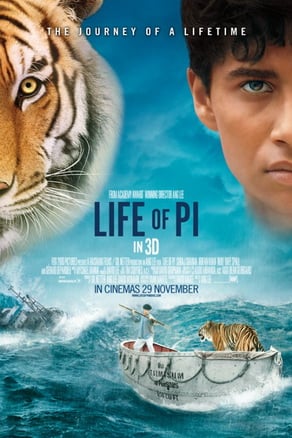
“Life of Pi” takes the realms of digital effects and cinematography by storm, but it ultimately leaves most viewers struggling to remain on board with its overblown — and consequently unsustainable — intent.
Despite commendable loyalty to Yann Martel’s novel, the film establishes its takeaway value in stunning imagery and effects. At times, the visuals seem overdone, such as during a daydream the protagonist Pi experiences as he looks into the ocean that essentially resembles an elaborate Windows XP screensaver. The film strives for a realistic effect evident through the meticulously lifelike quality of the digitally-created tiger. However, it also seeks to parade its own artful fantasy through elements like the daydream sequence, the living island and a flying fish onslaught.
Ang Lee successfully met the visual challenges of directing a reputedly unfilmable movie. After all, how could the premise of a boy and a tiger stranded at sea ever maintain any sort of visual interest? The few environments and characters in focus lead Lee to feature intriguing cinematography and effects as well as attention-grabbing mise-en-scene. Lee deserves utmost praise for “Life of Pi” if only for how he manages to give water new life, which he does in one way by manipulating the ocean’s biology.
Regarding the (usually) digitally-generated tiger known as Richard Parker, Pi’s recounted shipwreck story itself and the beautiful presentation of the oceanic environment, viewers have one outlook: We don’t care if it’s real or not, we just want to believe it. This viewers’ perspective, not coincidentally, ties into Pi’s religious sampling of Hinduism, Christianity and Islam. Pi searches not so much for truth as for something worth believing in.
Some viewers have criticized this movie as beautiful but hollow. I would somewhat agree given how I (along with what seemed to be the rest of the theater) was wholeheartedly enchanted by the movie but felt not enough narrative substance endured. The film is a captivating vision with messages, subject matter and symbolism far too vast and ambitious to properly absorb, leaving something to be desired despite already feeling overextended. However, the presentation-driven implications of the narrative give it redemption it otherwise lacks — and lack it does if only because of (spoiler alert) the questionable truth of its story that leaves viewers feeling betrayed. The twist, though, is not exactly open to criticism considering its loyalty to the novel.
In this sense of how the film may be received, the overwhelming yet unclear nature of the movie grants us insight into Pi’s encountered contradictions, skepticism, desire to believe and curiosity that drive his spiritual evolution. The narrative’s propulsion of give-and-take between viewers’ and Pi’s perspectives, like a storm driving the rise and fall of waves, engages audiences along with Ang Lee’s directive genius.
Many subjects of this film relate to the term “a new life”— the Patel family’s relocation to America, Pi’s spirituality, even the verity of Pi’s life at sea. However, most of all, “Life of Pi” gives new life to Ang Lee’s reputation as a director and especially to the expanding potential of CGI.
